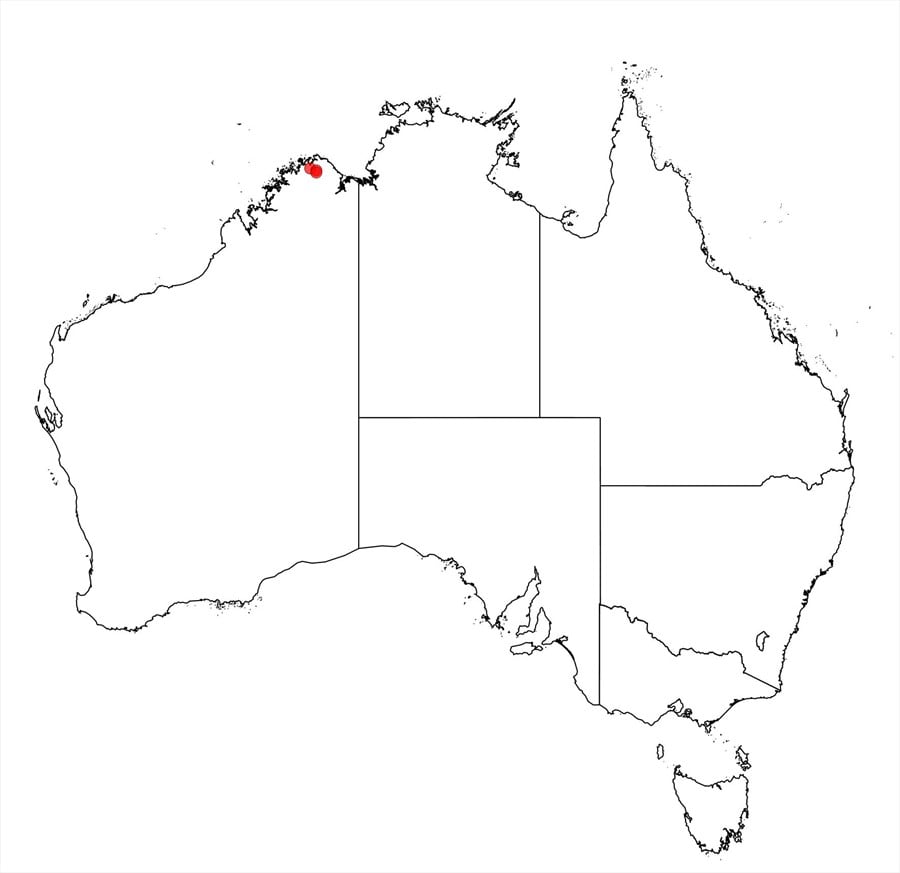Acacia anastomosa Maslin, M.D.Barrett & R.L.Barrett
WATTLE
Acacias of Australia
Common Name
Carson River Wattle
Family
Fabaceae
Distribution
Occurs in the Kimberley region of northern W.A. where it is known only from S of Kalumburu.
Description
Spindly, predominantly glabrous shrub1–2 m tall. Bark smooth, brown. Branchlets angled at extremities but soon terete, dark red aging greyish, not pruinose. Phyllodes narrowly elliptic or sometimes obovate, mostly dimidiate with lower margin straight or shallowly convex and upper margin clearly convex, mostly 5–9 cm long and 15–25 mm with l: w = 2.5–4.5, with 2–4 main longitudinal nerves (plus a few imperfect and/or less discrete ones) of which some or all are confluent with lower margin at base, minor nerves forming an open net-like reticulum comprising ±irregularly square to oblong nerve-islands c. 1–3 mm long; gland 0–2 mm above pulvinus. Inflorescences simple; peduncles 8–17 mm long; spikes 10–17 mm long and rather densely flowered. Flowers 5-merous; calyx c. 1/3 length of corolla, shortly dissected into triangular to broadly triangular lobes. Pods narrowly oblong to narrowly oblong-oblanceolate, narrowed towards the base, 5–10 cm long, 7–10 mm wide, crustaceous to ±sub-woody, straight, opening elastically from apex with the dehisced valves strongly recurved (often forming a ±open coil), marginal nerve thick. Seeds (immature) oblique, seated in shallow but distinct chambers each separated by a narrow septum.
Phenology
Difficult to accurately assess phenology because of paucity of collections but flowers collected from Apr.–June; mature seed not seen.
Habitat
Grows on red volcanic soil in open woodland with Eucalyptus tectifica, Corymbia greeniana and Erythrophleum chlorostachys over Gossypium exiguum, Chrysopogon fallax and C. latifolius.
Specimens
W.A.: [localities withheld for conservation reasons] J.R.Maconochie 1245 (DNA, PERTH); M. McDonald MM 1890 (PERTH).
Notes
Seemingly most closely related to A. limbata which is distinguished by its normally longer peduncles (mostly 20–40 mm), wider pods (mostly 10–15 mm) and by its phyllodes which are commonly continuous with the branchlets along their lower margin (never continuous in A. anastomosa) and which possess fewer anastomosing nerves that form clearly elongated nerve-islands about 5–12 mm long. Acacia anastomosa has a superficial resemblance to A. synantha but the relationship is probably not especially close.
Conservation
Classified as Priority One under Department of Parks and Wildlife Conservation Codes for Western Australian Flora.
FOA Reference
Flora of Australia Project
Author
B.R.Maslin
This identification key and fact sheets are available as a mobile application:
URL: https://apps.lucidcentral.org/wattle/
© Copyright 2018. All rights reserved.






